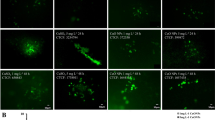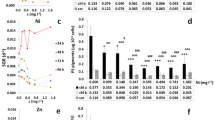Abstract
Chemical techniques were investigated in order to eradicate Caulerpa taxifolia, a green alga spreading at a remarkable rate in the Mediterranean Sea. The action of copper, potassium and sodium ions on survival rates and photosynthetic parameters was compared, in order to optimise the conditions of further in situ treatments. The lethal doses were determined and the impact of the studied cations on photosynthesis and respiration rates and PSII photochemistry was analysed from measurements of net oxygen exchanges and chlorophyll fluorescence. The Cu2+ concentrations required to obtain 100% mortality were 15 × 102 to 104 times lower than those of K+ and Na+. Respiration was slightly affected whatever the salt concentration,while photosynthesis could be totally inhibited depending on the applied treatment. Changes in the structure of the Ribulose-1,5-biphosphate carboxylase/oxygenase (RubisCO, EC: 4.1.1.39) were also detected when C. taxifolia under went cation treatments (10 mg L-1 Cu2+, 1h; 20 gL-1 K+, 3 h; 20 g L-1 Na+, 1 h). Given the high concentration and long incubation periods required with K+ and Na+ ions, these cations are not suitable to be used in situ. Our results make possible the utilisation of copper cations following technical approaches such asion-exchange textile covers, which allows a controlled release of cupric ions without dissemination in the marine environment.
Similar content being viewed by others
References
Andrews JT, Lorimer GH (1987) RubisCO: structure, mechanisms and prospects for improvement. In Hatch MD, Boardman NK (eds), The Biochemistry of Plants. Academic Press, New York, 10: 132-219.
Blackwell JR, Gilmour DJ (1991) Physiological response of the unicellular green alga Chlorococcum submarinum to rapid changes in salinity. Arch. Microbiol. 157: 86-91.
Escoubet S, Dupeux D, Escoubet P (1998) Utilisation du chlorure de sodium comme moyen d'éradication de Caulerpa taxifolia (Vahl) C. Agardh. In Boudouresque CF, Gravez V, Meinesz A, Palluy F (eds), Third International Workshop on Caulerpa taxifolia. GIS Posidonie, Marseille, France: 117-124.
Gacia E, Rodriguez-Prieto C, Delgado O, Ballesteros E (1996) Seasonal light and temperature responses of Caulerpa taxifolia from the north-western Mediterranean. Aquat. Bot. 53: 215-225.
García-Ferris C, Moreno J (1994) Oxidative modification and breakdown of ribulose-1,5-bisphosphate carboxylase/oxygenase induced in Euglena gracilis by nitrogen starvation. Planta 193: 208-215.
Gavach C, Sandeaux R, Sandeaux J, Souard R, Uchimura M, Escoubet P (1996) Technique de destruction de Caulerpa taxifolia par émission d'ions cuivriques au moyen d'un panneau à membrane permsélective. In Ribera A, Ballesteros E, Boudouresque CF, Gomez A, Gravez V (eds) Second international workshop onCaulerpa taxifolia. Universitat de Barcelona, Spain: 139-144.
Gayol P, Falconetti C, Chisholm JRM, Jaubert JM (1995) Metabolic responses of low-temperature-acclimated Caulerpa taxifolia (Chlorophyta) to rapidly elevated temperature. Bot. mar. 38: 61-67.
Gnassia-Barelli M, Romeo M, Laumond F, Pesando D (1978) Experimental studies on the relationship between natural copper complexes and their toxicity to phytoplankton. Mar. Biol. 47: 15-19.
Guerriero A, Meinesz A, D'Ambrosio M, Pietra F (1992) Isolation of toxic and potentially toxic sesqui-and monoterpenes from the tropical green seaweed Caulerpa taxifolia which has invaded the region of Cap Martin and Monaco. Helvetica Chim. Acta 75: 689-695.
Jousson O, Pawlowski J, Zaninetti L, Meinesz A, Boudouresque CF (1998) Molecular evidence for the aquarium origin of the green alga Caulerpa taxifolia introduced to the Mediterranean Sea. Mar. Ecol. Progr. Ser. 172: 275-280.
Karsten U, Kirst GO (1989) Intracellular solutes, photosynthesis and respiration of the green alga Blidingia minima in response to salinity stress. Bot. Acta 102(2): 123-128.
Krause GH, Weis E (1991) Chlorophyll fluorescence and photosynthesis: the basics. Ann. Rev. Plant Physiol. Plant Mol. Biol. 42: 313-349.
Laemmli UK (1970) Cleavage of structural proteins during the assembly of the head of the bacteriophage. T4. Nature 227: 680-685.
Lemée R, Boudouresque CF, Gobert J, Malestroit P, Mari X, Meinesz A, Menager V, Ruitton S (1996) Feeding behaviour of Paracentrotus lividus in the presence of Caulerpa taxifo23 lia introduced in the Mediterranean Sea. Oceanolog. Acta 19: 245-253.
McKnight DM, Morel FMM (1982) Copper complexation by siderophores from filamentous blue-green algae. Limnol. Oceanogr. 25: 62-71.
Mehta RA, Fawcett TW, Porath D, Mattoo AK (1992) Oxidative stress causes rapid membrane translocation and in vivo degradation of Ribulose-1,5-bisphosphate Carboxylase/Oxygenase. J. Biol. Chem. 267(4): 2810-2816.
Meinesz A, Hesse B (1991) Introduction et invasion de l'algue tropicale Caulerpa taxifolia en Méditerranée nord-occidentale. Oceanolog. Acta 14: 415-426.
Nato A, Mathieu Y (1978) Changes in Phosphenolpyruvate Carboxylase and Ribulose-biphosphate Carboxylase activities during the photoheterotrophic growth of Nicotiana tabaccum (cv Xanthi) cell suspensions. Plant Sci. Lett. 13: 49-56.
Nato A, Mirshahi A, Tichtinsky G, Mirshahi M, Faure JP, Lavergne D, De Buyser J, Jean C, Ducreux G, Henry Y (1997) Immunological detection of potential signal-transduction proteins expressed during wheat somatic tissue culture. Plant Physiol. 113: 801-807.
Paul VJ, Littler MM, Littler DS, Fenical W (1987) Evidence for chemical defence in tropical green alga Caulerpa ashmeadii (Caulerpaceae: Chlorophyta): isolation of new bioactive sesquiterpenoids. J. Chem. Ecol. 13 (5): 1171-1185.
Ragan MA, Glombitza KW (1986) Phlorotannins, brown algal polyphenols. In Round and Chapman (eds), Progress in Phycological Research. Biopress, Bristol: 129-241.
Triques K, Rival A, Beulé T, Puard M, Roy J, Nato A, Lavergne D, Havaux M, Verdeil JL, Sangare A, Hamon S (1997) Photosynthetic ability of in vitro grown coconut (Cocos nucifera L.) plantlets derived from zygotic embryos. Plant Sci. 127: 39-51.
Uchimura M, Sandeaux R, Larroque C (1999) The enzymatic detoxifying system of a native Mediterranean Scorpio fish is affected by Caulerpa taxifolia in its environment. Environ. Sci. Technol. 33: 1671-1674.
Zirino A, Yamamoto S (1972) A pH-dependent model for the chemical speciation of copper, zinc, cadmium and lead in seawater. Limnol. Oceanogr. 17: 661-671.
Author information
Authors and Affiliations
Rights and permissions
About this article
Cite this article
Uchimura, M., Rival, A., Nato, A. et al. Potential use of Cu2+, K+ and Na+ for the destruction of Caulerpa taxifolia: differential effects on photosynthetic parameters. Journal of Applied Phycology 12, 15–23 (2000). https://doi.org/10.1023/A:1008108531280
Issue Date:
DOI: https://doi.org/10.1023/A:1008108531280




